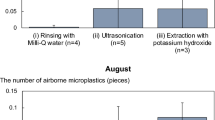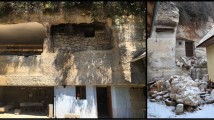Abstract
The scanning electron microscope (SEM) is useful in the identification of biogenic opal. Opaline spheres, cups, and scrolled or convoluted sheets were identified in both soil and vegetative isolates. X-ray diffraction analysis indicates that both alpha quartz and cristobalite were co-associated with the amorphous opaline phase synthesized during life metabolism of deciduous tree leaves. Such crystalline phases were most abundant in the 2–5 μm fraction and many consist of anitsotropic rods with parallel extinction or equidimensional bodies with aggregate extinction. Between 2/3 and 3/4 of the total opal isolate from deciduous tree leaves was solubilized when digested for 2–5-min in boiling 0.5 N NaOH. Rate of dissolution was a function of particle-size and tree species. Biogenic opal of forest origin was about 10–15 times more soluble than grass opal, which probably reflects the higher specific surface of the former.
Résumé
Le microscope électronique à balayage (SEM) est très utile pour l’identification de l’opale biogène. Des sphères d’opaline, des cupules et des feuillets en volutes ou enroulés, ont été identifiés à la fois dans des fractions isolées à partir de sols ou de végétaux. L’analyse par diffraction X indique que du quartz alpha et de la cristobalite sont associés avec la phase opale amorphe synthétisée durant le métabolisme des feuilles d’arbres à feuilles caduques. De telles phases cristallines sont les plus abondantes dans la fraction 2–5 μm, et beaucoup d’entre elles consistent en des bâtonnets anisotropes à extinction parallèle ou en des masses équidimensionnelles avec une extinction d’aggrégat. De 2/3 à 3/4 de l’opale totale isolée des feuilles d’arbres à feuilles caduques est solubilisée lors d’un traitement de 2,5 min dans NaOH 0,5 N bouillant. La vitesse de dissolution est fonction de la taille des particules et de l’espèce de l’arbre. L’opale biogène forestière est environ 10–15 fois plus soluble que l’opale venant de l’herbe, ce qui indique probablement une surface spécifique plus élevée pour la première.
Kurzreferat
Das Rasterelektronenmikroskop (SEM) ist brauchbar für die Identifizierung von biogenem Opal. Kugeln, Schalen und gerollte oder gewundene Blättchen aus Opal wurden sowohl in Fraktionen aus Böden als auch aus Pflanzematerial nachgewiesen. Die Röntgenbeugungsanalyse zeight, daß sowohl α-Quarz als auch Cristobalit mit der amorphen Opalphase vergesellschaftet sind, die im Verlauf des Lebensstoffwechsels von Laubbaumblättern synthetisiert wird. Solche kristallinen Phasen traten am häufigsten in der 2–5 μm-Fraktion auf und bestehen vielfach aus anisotropen Stäbchen mit paralleler Auslöschung oder aus Körpern mit gleichen Achsenlängen und Aggregatauslöschung. Zwischen 2/3 und 3/4 der gesamten aus Laubbaumblättern isolierten Opalfraktionen lösen sich nach 2,5 minütiger Behandlung in kochender 0,5 N NaOH. Die Auflösungsrate war eine Funktion der Korngröße und der Baumart. Biogener Opal forstlichen Ursprungs war etwa 10–15 mal löslicher als Grass-Opal, was wahrscheinlich die höhere spezifische Oberfläche des erstgenannten widerspiegelt..
Резюме
Растровый электронный микроскоп полезен при выяснении природы биогенного опала. Опаловые шарики, чашечки и витковые или свернутые листки найдены как в земляных, так и в растительных выделениях. Рентгенографический анализ показывает, что как альфа квартц, так и кристобалит связаны с аморфной опаловой фазой, образовавшейся во время жизненного метаболизма листьев лиственных деревьев. Эти кристаллические фазы обильнее всего встречаются во фракции 2–5 /хм и могут состоять из анизотропических палочек с параллельной экстинкцией или с телами одинаковой размерности с экстинкцией агрегата. Между 2/3 и 3/4 общего опалового выделения из листьев лиственных пород растворилось при вываривании в течение 2,5 минут в кипящем 0,5 N NaOH. Скорость растворения зависит от размера частицы и от породы дерева. Биогенный опал лесного происхождения растворяется в 10–15 раз скорее, чем травяной опал, что, возможно, отражает более высокую удельную поверхность первого.
Similar content being viewed by others
References
Alexaides, C. A. and Jackson, M. L. (1966) Quantitative clay mineralogical analysis of soils and sediments: Clays and Clay Minerals 14, 35–52.
Arimura, S. and Kanno, I. (1965) Some mineralogical and chemical characteristics of plant opals in soils and grasses of Japan: Bull, of the Kyushu Agric. Expt. Sta. 11, 111–120.
Beavers, A. H. and Stephen, I. (1958) Some features of the distribution of plant opal in Illinois soils: Soil Sci. 86, 1–5.
Bohor, B. F. and Hughes, R. E. (1971) Scanning electron microscopy of clays and clay minerals: Clays and Clay Minerals 19, 49–54.
Bonnett, O. T. (1972) Silicified cells of grasses: A major source of plant opal in Illinois: Agric. Expt. Sta. Bull. 742, 1–36.
Drum, R. W. (1968) Siliciflcation of Betula woody tissue in vitro: Science 161, 175–176.
Geis, J. W. (1973) Biogenic silica in selected species of deciduous angiosperms: Soil Sci. Soc. Am. Proc. 116 (2), 113–119.
Gill, E. D. (1967) Stability of biogenetic opal: Science 158, 810.
Henderson, J. H., Clayton, R. N., Jackson, M. L., Syers, J. K., Rex, R. W., Brown, J. L. and Sachs, I. B. (1972) Cristo-balite and quartz isolation from soils and sediments by hydrofluosilicic acid treatment and heavy liquid separation: Soil Sci. Soc. Am. Proc. 36, 830–835.
Hashimoto, I. and Jackson, M. L. (1960) Rapid dissolution of allophane and kaolinite-halloysite after dehydration: In Clays and Clay Minerals, 7th Conf., pp. 102–113.
Jones, R. L. (1969) Determination of opal in soil by alkali dissolution analysis: Soil Sci. Soc. Am. Proc. 33, 976–978.
Jones, R. L. and Beavers. A. H. (1963) Sponge spicules in Illinois soils: Soil Sci. Soc. Am. Proc. 27, 438–440.
Jones, R. L. and Beavers, A. H. (1964) Aspects of catenary and depth distribution of opal phytoliths in Illinois soils: Soil Sci. Soc. Am. Proc. 28, 413–416.
Jones, L. H. P. and Handreck, K. A. (1963) Effects of iron and aluminum oxides on silica in solution in soils: Nature 198, 852–853.
Jones, L. H. P. and Handreck, K. A. (1967) Silica in soils, plants and animals: In Advances in Agronomy, Vol. 19, pp. 107–149. Academic Press, New York.
Jones, L. H. P. and Milne, A. A. (1963) Studies of silica in the oat plant—I: Plant and Soil 18, 207–220.
Jones, J. B., Segnit, E. R. and Nickson, N. M. (1963) Differential thermal and X-ray analysis of opal: Nature 198, 1191.
Jones, J. B., Sanders, J. V. and Segnit, E. R. (1964) Structure of opal: Nature 204, 990–991.
Lanning, F. C., Ponnaiya, R. W. X. and Crumpton, C. F. (1958) The chemical nature of silica in plants: Plant Physiol. 33, 339–343.
Lewin, J. C. (1961) The dissolution of silica from diatom walls: Geochim. Cosmochim. Acta 21, 182–198.
McKeague, J. A. and Cline, M. S. (1963) Silica in soils. In Advances in Agronomy, Vol. 15, pp. 339–396. Academic Press, New York.
Mizutani, S. (1967) Kinetic aspects of diagenesis of silica in sediments: J. Earth Sciences 15, 99–111.
Rovner, I. (1971) Potential of opal phytoliths for use in paleocological reconstruction: Quaternary Res. 1, 343–359.
Smithson, F. (1958) Grass opal in British soils: J. Soil Sci. 9, 148–154.
Siever, R. and Scott, R. A. (1963) Organic geochemistry of silica: In Organic Geochemistry, pp. 579–595. Pergamon Press, New York.
Teodorovich, G. I. (1961) Authigenic, principally syngenetic minerals in sedimentary rocks, their characteristics, conditions of formation, and classification: In Authigenic Minerals in Sedimentary Rocks, pp. 17–21. Consultants Bureau, New York.
Twiss, P. C., Suess, E. and Smith, R. M. (1969) Morphological classification of grass phytoliths: Soil Sci. Soc. Am. Proc. 33, 109–115.
Wilding, L. P. (1967) Radiocarbon dating of biogenetic opal: Science 156, 66–67.
Wilding, L. P., Brown, R. E. and Holowaychuk, N. (1967) Accessibility and properties of occluded carbon in biogenetic opal: J. Soil Sci. 101, 56–61.
Wilding, L. P. and Drees, L. R. (1968) Biogenic opal in soils as an index of vegetative history in the Prairie Peninsula: In The Quaternary of Illinois (Edited by Bergstrom, R. E.), Vol. 14, pp. 96–103. University of Illinois, College of Agriculture Special Publication.
Wilding, L. P. and Drees, L. R. (1971) Biogenic opal in Ohio soils: Soil Sci. Soc. Am. Proc. 35, 1004–1010.
Wilding, L. P. and Drees, L. R. (1972) Contribution of biogenic opal to soils and subsequent transformation to crystalline components: International Clay Conference Abstracts, Madrid, Spain, pp. 246–247.
Wilding, L. P. and Drees, L. R. (1973) Scanning electron microscopy of opaque opaline forms isolated from forest soils in Ohio: Soil Sci. Soc. Am. Proc. 37, 647–650.
Wilding, L. P. and Geissinger, H. D. (1973) Correlative light optical and scanning electron microscopy of minerals: a methodology study: J. Sed. Petrology, 43, 280–286.
Yarilova, E. A. (1952) Phytolitharian crystallization in the soil: Dok Akad. Naud. U.S.S.R.) 83, 911–912; Chem. Abs. 46, 8301d.
Author information
Authors and Affiliations
Rights and permissions
About this article
Cite this article
Wilding, L.P., Drees, L.R. Contributions of Forest Opal and Associated Crystalline Phases to Fine Silt and Clay Fractions of Soils. Clays Clay Miner. 22, 295–306 (1974). https://doi.org/10.1346/CCMN.1974.0220311
Received:
Published:
Issue Date:
DOI: https://doi.org/10.1346/CCMN.1974.0220311




